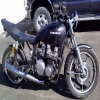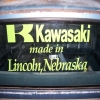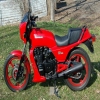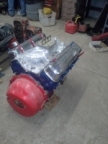- Posts: 386
- Thank you received: 1
I'm trying to build an Engine Dyno
- Becker
-
 Topic Author
Topic Author
- Offline
- User
- The Doctor Will Rise Again
Less
More
17 Sep 2009 15:39 #322237
by Becker
78 KZ750B3
79 KZ400 LTD
78 KZ650C2
79 KZ650C3
78 KZ650B2A
80 KZ650F1
80 KZ650E1
81 CB750K Super Sport
I'm trying to build an Engine Dyno was created by Becker
Ok so I really want to build an engine dyno for rebuilding/testing/tuning motors. I have alot of scrap metal to build with and a millermatic 200 welder (actually its my dads stuff but he is quite generous with his tools and metal. can't thank him enough). I started drawing things up for the framework. I'm making it adjustable to fit more motors then just my 650's. I'm planning it to be the type that uses a flywheel and the motor needs to accelerate the flywheel.
So now for the questions.
First, if I attach the motor by the bottom motor mounts will it hold for full runs??
Second, how do I calculate gearing and weight for the flywheel??
Third, anyone know how to keep the engine cool while making dyno runs?? How do I measure the temperature of the motor?? Oil temp?? Laser temp sensor on the heads??
Fourth, what kind of sensor do you need to track the RPM's of the flywheel and how can I graph it vs time?? Anything will help I have no idea what direction to go in.
Fifth, I'm already planning on RPM's, temp, and maybe Air Fuel ratios for gauges, and Clutch, throttle, gear change, flywheel brake, and ignition switch for controls. Anything else I need??
Finally, is this even plausible?? I'm no dope when it comes to machining, welding, or the mathmetics of engines but I may be getting in to deep. Either way it should be fun to try. Any suggestions or anything else to comment on would help.
Oh ya and pictures will be coming.
So now for the questions.
First, if I attach the motor by the bottom motor mounts will it hold for full runs??
Second, how do I calculate gearing and weight for the flywheel??
Third, anyone know how to keep the engine cool while making dyno runs?? How do I measure the temperature of the motor?? Oil temp?? Laser temp sensor on the heads??
Fourth, what kind of sensor do you need to track the RPM's of the flywheel and how can I graph it vs time?? Anything will help I have no idea what direction to go in.
Fifth, I'm already planning on RPM's, temp, and maybe Air Fuel ratios for gauges, and Clutch, throttle, gear change, flywheel brake, and ignition switch for controls. Anything else I need??
Finally, is this even plausible?? I'm no dope when it comes to machining, welding, or the mathmetics of engines but I may be getting in to deep. Either way it should be fun to try. Any suggestions or anything else to comment on would help.
Oh ya and pictures will be coming.
78 KZ750B3
79 KZ400 LTD
78 KZ650C2
79 KZ650C3
78 KZ650B2A
80 KZ650F1
80 KZ650E1
81 CB750K Super Sport
Please Log in or Create an account to join the conversation.
- thompsonmx100
-

- Offline
- User
Less
More
- Posts: 425
- Thank you received: 0
17 Sep 2009 15:48 #322240
by thompsonmx100
2006 gs 500 streetfighter
1982 gpz750 breathed on wreck
1985 gpz750
Kz 650
Replied by thompsonmx100 on topic I'm trying to build an Engine Dyno
this might help you with the engine stand part of the equation. Although a dyno sounds a little complicated to build.
2006 gs 500 streetfighter
1982 gpz750 breathed on wreck
1985 gpz750
Kz 650
Attachments:
Please Log in or Create an account to join the conversation.
- roy-b-boy-b
-

- Offline
- User
Less
More
- Posts: 3255
- Thank you received: 103
17 Sep 2009 15:53 #322241
by roy-b-boy-b
1979 LTD Street Fighter.1977 KZ1000
Replied by roy-b-boy-b on topic I'm trying to build an Engine Dyno
I know nutin about dynos.
I do know i have a friend that built a Honda that had that intake set up. Roy
I do know i have a friend that built a Honda that had that intake set up. Roy
1979 LTD Street Fighter.1977 KZ1000
Please Log in or Create an account to join the conversation.
- stardon
-

- Offline
- User
Less
More
- Posts: 45
- Thank you received: 5
17 Sep 2009 17:15 #322257
by stardon
Replied by stardon on topic I'm trying to build an Engine Dyno
I remember an article years ago about some guys who built a dyno using a old torque converter from an automatic transmission. By controlling the amount of fluid in the torque converter they could vary the amount of drag and using a arm with springs they could measure the torque output.
Please Log in or Create an account to join the conversation.
- PLUMMEN
-

- Offline
- User
Less
More
- Posts: 8139
- Thank you received: 104
17 Sep 2009 18:03 #322267
by PLUMMEN
Still recovering,some days are better than others.
Replied by PLUMMEN on topic I'm trying to build an Engine Dyno
heres a picture of my dyno,it does a good job of telling me when its time to shift! only cost $30,000.00 and installs in a few hours :laugh:
Still recovering,some days are better than others.
Attachments:
Please Log in or Create an account to join the conversation.
- keith1
- Offline
- User
Less
More
- Posts: 1729
- Thank you received: 2
17 Sep 2009 18:24 #322270
by keith1
Replied by keith1 on topic I'm trying to build an Engine Dyno
Please Log in or Create an account to join the conversation.
- loudhvx
-

- Offline
- KZr Legend
Less
More
- Posts: 10864
- Thank you received: 1615
17 Sep 2009 19:22 #322285
by loudhvx
1981 KZ550 D1 gpz.
Kz550 valve train warning.
Other links.
Replied by loudhvx on topic I'm trying to build an Engine Dyno
You need something that can sink a LOT of power. At wide open throttle, you need something that can soak up all of the engine's power. That's a lot.
For example, I used to use the back brake on the center stand. After one 5 second run at WOT, the disk was super hot. After another run, the disk was starting to turn blue on the surface.
That's only 10 seconds of full throttle. You will need something that can absorb all that heat. You could use a 100 horsepower generator to heat up a swimming pool. That'd probably be adequate for long runs.
For example, I used to use the back brake on the center stand. After one 5 second run at WOT, the disk was super hot. After another run, the disk was starting to turn blue on the surface.
That's only 10 seconds of full throttle. You will need something that can absorb all that heat. You could use a 100 horsepower generator to heat up a swimming pool. That'd probably be adequate for long runs.
1981 KZ550 D1 gpz.
Kz550 valve train warning.
Other links.
Please Log in or Create an account to join the conversation.
- Becker
-
 Topic Author
Topic Author
- Offline
- User
- The Doctor Will Rise Again
Less
More
- Posts: 386
- Thank you received: 1
18 Sep 2009 12:01 #322401
by Becker
78 KZ750B3
79 KZ400 LTD
78 KZ650C2
79 KZ650C3
78 KZ650B2A
80 KZ650F1
80 KZ650E1
81 CB750K Super Sport
Replied by Becker on topic I'm trying to build an Engine Dyno
Ya my initial idea was for a prony brake made from a car disk brake but after some calculations about the heat I realized that was impossible so now I'm going with an inertia type. The engine will be connected to a flywheel and start at idle in high gear. Then you hold her to the boards while you measure the RPM increase at the Flywheel. A buddy of mine who is much better at physics gave me all the calculations I will need, even though I don't really understand them. Now I need to figure out how to measure and graph the RPM increases at the flywheel and how much it should weigh and at what diameter. This should be much easier to make then a prony brake because I don't have to worry about heat dissipatation. The down side is I can't just hold it at one RPM and tune it there, it has to always be accelerating.
I do have 2 ideas to measure the increase in speed of the flywheel versus time though.
1. Hall effect sensor, I know they can do this but data aquistion may be hard.
2. Connect a single phase flywheel and rotor to it and measure the voltage output. The way I understand it, alternators put out more voltage the faster they spin so if I can find a conversion factor between RPM's and voltage output I could turn my voltage numbers into RPM's. And If I can track the increase in voltage vs time I could write a program that would calculate horsepower from the voltage numbers I'm getting... I think. Lou you know a lot more about this stuff then me. Is it possible to get an accurate reading out of an alternator??
I do have 2 ideas to measure the increase in speed of the flywheel versus time though.
1. Hall effect sensor, I know they can do this but data aquistion may be hard.
2. Connect a single phase flywheel and rotor to it and measure the voltage output. The way I understand it, alternators put out more voltage the faster they spin so if I can find a conversion factor between RPM's and voltage output I could turn my voltage numbers into RPM's. And If I can track the increase in voltage vs time I could write a program that would calculate horsepower from the voltage numbers I'm getting... I think. Lou you know a lot more about this stuff then me. Is it possible to get an accurate reading out of an alternator??
78 KZ750B3
79 KZ400 LTD
78 KZ650C2
79 KZ650C3
78 KZ650B2A
80 KZ650F1
80 KZ650E1
81 CB750K Super Sport
Please Log in or Create an account to join the conversation.
- loudhvx
-

- Offline
- KZr Legend
Less
More
- Posts: 10864
- Thank you received: 1615
20 Sep 2009 05:44 - 20 Sep 2009 05:56 #322633
by loudhvx
1981 KZ550 D1 gpz.
Kz550 valve train warning.
Other links.
Replied by loudhvx on topic I'm trying to build an Engine Dyno
The Hall-effect sensor coupled to a circuit for RPM would be, by far, more accurate. Using a Hall-effect sensor or optical sensor (or even a reluctor like the factory electronic ignition uses) can be coupled to a cheap $30 tach for a car.
An alternator does change voltage with RPM, but the relationship is not linear, and as RPMs increase, the voltage can actually go back down after peaking since the inductance of the alternator will limit the frequency at which the alternator will produce power. Also, the RPM/voltage relationship will be very dependent on how the alternator is loaded.
A Sunpro minitach hooked up to a sensor is definitely a better way to go, and should have minimal construction requirements. It'll definitely be easier than connecting an alternator.
Another option is to just buy an industrial handheld tach device. They can measure RPM with a laser. Some of them would be too slow for what you are doing, though.
If you are using the dyno to study the jetting on carburetors, that would be tricky. You need to be able to hold steady RPM's while cruising. I don't know how you would simulate wind resistance etc. When I was doing tests using a wideband o2 sensor, the air-fuel reading would change at steady throttle depending simply on how I sat on the bike. I a tucked position, the AFR showed leaner because the bike would speed up and the RPM increased (while the throttle was held steady). It showed richer if going up hill, and leaner if going downhill.
If determining jetting is your goal, I would get the Innovate wideband setup and ride around with it. Then you will get a feel for what the AFR does under different conditions. Then you will know what conditions you want to simulate with a dyno.
Here's a link to the O2 sensor thread.
kzrider.com/index.php?option=com_kunena&...ew&catid=3&id=307483
Oh, and I forgot to mention, the Innovate o2 sensor can be hooked up to a few different datalogging devices they have. It will graph engine RPM, AFR, throttle position (if you make a TPS), etc. After your runs, you upload the data to a PC. Obviously, all of this will work with a dyno too. You can also have inputs to the datalogger for temperature, speed etc. ...pretty much anything you can convert into an electrical signal can be logged. Some oftheir loggers can record 32 channels of data. I'd get the DL-32 as opposed to the LM-2. The LM-2 seems temperamental.
An alternator does change voltage with RPM, but the relationship is not linear, and as RPMs increase, the voltage can actually go back down after peaking since the inductance of the alternator will limit the frequency at which the alternator will produce power. Also, the RPM/voltage relationship will be very dependent on how the alternator is loaded.
A Sunpro minitach hooked up to a sensor is definitely a better way to go, and should have minimal construction requirements. It'll definitely be easier than connecting an alternator.
Another option is to just buy an industrial handheld tach device. They can measure RPM with a laser. Some of them would be too slow for what you are doing, though.
If you are using the dyno to study the jetting on carburetors, that would be tricky. You need to be able to hold steady RPM's while cruising. I don't know how you would simulate wind resistance etc. When I was doing tests using a wideband o2 sensor, the air-fuel reading would change at steady throttle depending simply on how I sat on the bike. I a tucked position, the AFR showed leaner because the bike would speed up and the RPM increased (while the throttle was held steady). It showed richer if going up hill, and leaner if going downhill.
If determining jetting is your goal, I would get the Innovate wideband setup and ride around with it. Then you will get a feel for what the AFR does under different conditions. Then you will know what conditions you want to simulate with a dyno.
Here's a link to the O2 sensor thread.
kzrider.com/index.php?option=com_kunena&...ew&catid=3&id=307483
Oh, and I forgot to mention, the Innovate o2 sensor can be hooked up to a few different datalogging devices they have. It will graph engine RPM, AFR, throttle position (if you make a TPS), etc. After your runs, you upload the data to a PC. Obviously, all of this will work with a dyno too. You can also have inputs to the datalogger for temperature, speed etc. ...pretty much anything you can convert into an electrical signal can be logged. Some oftheir loggers can record 32 channels of data. I'd get the DL-32 as opposed to the LM-2. The LM-2 seems temperamental.
1981 KZ550 D1 gpz.
Kz550 valve train warning.
Other links.
Last edit: 20 Sep 2009 05:56 by loudhvx.
Please Log in or Create an account to join the conversation.
- Becker
-
 Topic Author
Topic Author
- Offline
- User
- The Doctor Will Rise Again
Less
More
- Posts: 386
- Thank you received: 1
20 Sep 2009 15:32 #322808
by Becker
78 KZ750B3
79 KZ400 LTD
78 KZ650C2
79 KZ650C3
78 KZ650B2A
80 KZ650F1
80 KZ650E1
81 CB750K Super Sport
Replied by Becker on topic I'm trying to build an Engine Dyno
Thanks lou I knew you'd know where to go. I'm planning on using this mostly to see what happens when I port the heads differently, different pipes, ignition advance, cams, and all sorts of little tweaks and what their affect is. I'm not really planning on using it to jet except to get it to fairly close to what is right. I think I'm going to make some sort of hall effect sensor for it and see what happens. I'll probably hook a small tach up to the flywheel just for reference purposes. If nothing else I could simply use a timer thats hooked up to the tach needle and kicks in at one RPM and kicks out at another RPM. It would be crude but it would measure the average output between those two RPM's. Looks like I still have alot of work to do before this becomes a real project.
78 KZ750B3
79 KZ400 LTD
78 KZ650C2
79 KZ650C3
78 KZ650B2A
80 KZ650F1
80 KZ650E1
81 CB750K Super Sport
Please Log in or Create an account to join the conversation.


